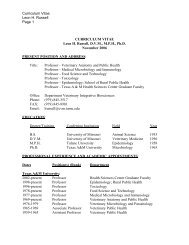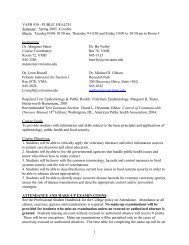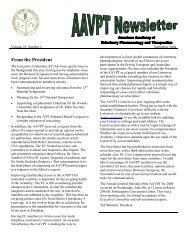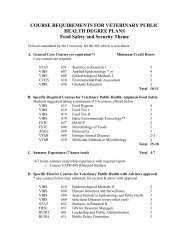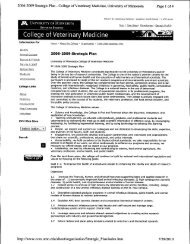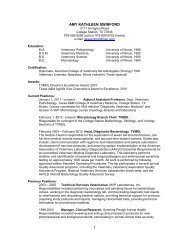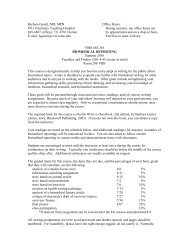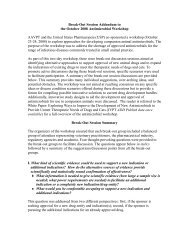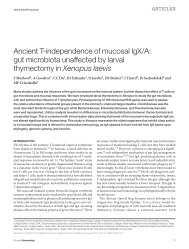Download PDF - College of Veterinary Medicine - Texas A&M ...
Download PDF - College of Veterinary Medicine - Texas A&M ...
Download PDF - College of Veterinary Medicine - Texas A&M ...
You also want an ePaper? Increase the reach of your titles
YUMPU automatically turns print PDFs into web optimized ePapers that Google loves.
Dr. Ashley observed two Army tech students working with a cow.<br />
years in Asia working in international development,<br />
instructing local populations in<br />
animal husbandry methods.<br />
“Teaching these classes is a lot <strong>of</strong><br />
fun,” Ashley said. “The attendees<br />
are so engaged in the classes,<br />
and we have a great audience <strong>of</strong><br />
senior enlisted men and women<br />
who have been chosen specifically<br />
for this task.”<br />
Ashley teaches the cattle<br />
and small ruminant sections<br />
and Dr. Brandon Dominguez,<br />
clinical assistant pr<strong>of</strong>essor at the<br />
CVM and <strong>Texas</strong> Department <strong>of</strong><br />
Criminal Justice clinician, leads<br />
the poultry and swine sections.<br />
Because most CAMS work in the field,<br />
the lessons are tailored to working in<br />
developing countires. Physical exams, blood<br />
sample collection, injections, and manual restraint<br />
are all instrument-based aspects <strong>of</strong> the education<br />
the attendees receive.<br />
“Working with cattle anywhere can be a dangerous<br />
task, but even more so in developing countries where<br />
modern and safe restraint equipment is not available,”<br />
Ashley said. “Therefore, in this class, I teach them useful<br />
skills like safe methods <strong>of</strong> restraint using just a rope and<br />
a halter to safely lay the animal down so it can be treated.<br />
In addition, I teach them how to do a complete exam<br />
and how to take blood and urine samples in the field.<br />
Working in the areas where these CAMS will be deployed<br />
can be very challenging. We want them to leave here with<br />
not only a skill set, but with confidence in working with<br />
animals.”<br />
S<strong>of</strong>aly is pleased with the program. “It’s worked<br />
out really well for us,” she said. “We give them a bit <strong>of</strong><br />
classroom knowledge, so when they get to the veterinary<br />
school they are able to gain the hands-on experience<br />
with the animals, and that’s something we can’t teach in<br />
the classroom. It adds a huge amount to their training.”<br />
Dominguez has led the swine and poultry<br />
sections <strong>of</strong> the course for the past year. He explained<br />
that because the CAMS will be expected<br />
to address both human and animal health<br />
needs, he can tailor his teaching to build on<br />
their experiences in human medicine.<br />
“We are really just bridging the gap between<br />
veterinary and human medicine with<br />
this course,” Dominguez said. “We want<br />
them to clearly recognize bacterial, viral, and<br />
parasitic disease problems in addition to field<br />
treatment.”<br />
Although the CAMS are not veterinarians,<br />
they perform examinations and are crucial in<br />
recognizing problems that need the intervention<br />
<strong>of</strong> an Army veterinarian.<br />
“We try to give the CAMS extra knowledge<br />
so they recognize where there’s a veterinary<br />
medical problem in areas where a veterinarian<br />
wouldn’t normally be called in,” Dominguez<br />
said. “CAMS have the potential to really<br />
benefit these populations; it’s great to be a<br />
part <strong>of</strong> this.”<br />
S<strong>of</strong>aly said CAMS are critical in the<br />
field.<br />
“When we’re deployed, there<br />
are veterinarians and veterinary<br />
technicians in the field, but we<br />
can’t be everywhere. CAMS are<br />
our eyes and ears for medical<br />
development, an extension for<br />
us for preventive and treatment<br />
medicine. They go more places<br />
than the veterinarians because<br />
vets are associated with a certain<br />
stationary area where animals are<br />
brought to us, while CAMS go to a lot<br />
more rural and remote places. They can<br />
really intervene and save lives.”<br />
An Army tech learned how to take a blood sample from a pig.<br />
CVM Today • Winter 2012 • 7




